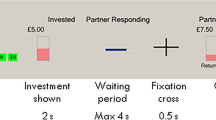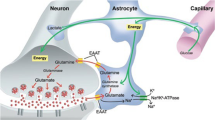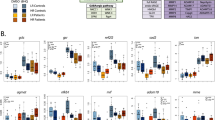Abstract
In light of current etiological concepts the glutamatergic system plays an essential role for the pathophysiology of the disorder, offering multiple options for new treatment strategies. The D-amino oxidase activator (DAOA) gene is closely connected to the glutamatergic system and its therapeutic and pathophysiological relevance for schizophrenia is therefore intensively debated. In a further step to shed light on the role of DAOA in schizophrenia, we aimed to investigate the association of the functional DAOA Arg30Lys (rs2391191) variant and cortical thickness in schizophrenia. Cortical thickness was computed by an automated surface-based technique (FreeSurfer) in 52 genotyped patients with schizophrenia and 42 healthy controls. Cortical thickness of the entire cortex was compared between risk carriers and non-risk carriers regarding the Arg30Lys polymorphism in patients and healthy controls on the basis of a node-by-node procedure and an automated clustering approach. Risk carriers with schizophrenia show significantly thinner cortex in two almost inversely arranged clusters on the left and right hemisphere comprising middle temporal, inferior parietal, and lateral occipital cortical areas. The clusters encompass an area of 1174 mm2 (left) and 1156 mm2 (right). No significant effect was observed in healthy controls.
The finding of our study that the Arg30Lys risk variant is associated with a distinct cortical thinning provides new evidence for the pathophysiological impact of DAOA in schizophrenia. The affected areas are mostly confined to cortical regions with a crucial role in the ToM network and visual processing, which both can be influenced by glutamatergic modulation. Our finding thus underlines the importance of DAOA and related glutamatergic processes as a putative target for therapeutic interventions in schizophrenia.
Similar content being viewed by others
Log in or create a free account to read this content
Gain free access to this article, as well as selected content from this journal and more on nature.com
or
References
Andreasen NC, Calarge CA, O’Leary DS (2008). Theory of mind and schizophrenia: a positron emission tomography study of medication-free patients. Schizophr Bull 34: 708–719.
Annett M (1967). The binomial distribution of right, mixed and left handedness. Q J Exp Psychol 19: 327–333.
Bora E, Yucel M, Pantelis C (2009). Theory of mind impairment in schizophrenia: meta-analysis. Schizophr Res 109: 1–9.
Brune M, Lissek S, Fuchs N, Witthaus H, Peters S, Nicolas V et al (2008). An fMRI study of theory of mind in schizophrenic patients with ‘passivity’ symptoms. Neuropsychologia 46: 1992–2001.
Chumakov I, Blumenfeld M, Guerassimenko O, Cavarec L, Palicio M, Abderrahim H et al (2002). Genetic and physiological data implicating the new human gene G72 and the gene for D-amino acid oxidase in schizophrenia. Proc Natl Acad Sci USA 99: 13675–13680.
Coleman MJ, Cestnick L, Krastoshevsky O, Krause V, Huang Z, Mendell NR et al (2009). Schizophrenia patients show deficits in shifts of attention to different levels of global-local stimuli: evidence for magnocellular dysfunction. Schizophr Bull 35: 1108–1116.
Coyle JT (2006). Glutamate and schizophrenia: beyond the dopamine hypothesis. Cell Mol Neurobiol 26: 365–384.
Coyle JT, Tsai G (2004). NMDA receptor function, neuroplasticity, and the pathophysiology of schizophrenia. Int Rev Neurobiol 59: 491–515.
Coyle JT, Tsai G, Goff D (2003). Converging evidence of NMDA receptor hypofunction in the pathophysiology of schizophrenia. Ann NY Acad Sci 1003: 318–327.
Dale AM, Fischl B, Sereno MI (1999). Cortical surface-based analysis. I. Segmentation and surface reconstruction. Neuroimage 9: 179–194.
Detera-Wadleigh S, McMahon F (2006a). G72/G30 in schizophrenia and bipolar disorder: review and meta-analysis. Biol Psychiatry 60: 106–114.
Detera-Wadleigh SD, McMahon FJ (2006b). G72/G30 in schizophrenia and bipolar disorder: review and meta-analysis. Biol Psychiatry 60: 106–114.
Di Perri C, Dwyer MG, Wack DS, Cox JL, Hashmi K, Saluste E et al (2009). Signal abnormalities on 1.5 and 3 Tesla brain MRI in multiple sclerosis patients and healthy controls. A morphological and spatial quantitative comparison study. Neuroimage 47: 1352–1362.
Donohoe G, Morris DW, Robertson IH, McGhee KA, Murphy K, Kenny N et al (2007). DAOA ARG30LYS and verbal memory function in schizophrenia. Mol Psychiatry 12: 795–796.
du Bois TM, Huang XF (2007). Early brain development disruption from NMDA receptor hypofunction: relevance to schizophrenia. Brain Res Rev 53: 260–270.
Ettlinger G (1990). ‘Object vision’ and ‘spatial vision’: the neuropsychological evidence for the distinction. Cortex 26: 319–341.
Fischl B, Dale AM (2000). Measuring the thickness of the human cerebral cortex from magnetic resonance images. Proc Natl Acad Sci USA 97: 11050–11055.
Fischl B, Sereno MI, Dale AM (1999). Cortical surface-based analysis. II: inflation, flattening, and a surface-based coordinate system. Neuroimage 9: 195–207.
Fischl B, van der Kouwe A, Destrieux C, Halgren E, Segonne F, Salat DH et al (2004). Automatically parcellating the human cerebral cortex. Cereb Cortex 14: 11–22.
Fornito A, Yucel M, Wood SJ, Adamson C, Velakoulis D, Saling MM et al (2008). Surface-based morphometry of the anterior cingulate cortex in first episode schizophrenia. Hum Brain Mapp 29: 478–489.
Gobbini MI, Koralek AC, Bryan RE, Montgomery KJ, Haxby JV (2007). Two takes on the social brain: a comparison of theory of mind tasks. J Cogn Neurosci 19: 1803–1814.
Green MF, Glahn D, Engel SA, Nuechterlein KH, Sabb F, Strojwas M et al (2005). Regional brain activity associated with visual backward masking. J Cogn Neurosci 17: 13–23.
Green MF, Nuechterlein KH, Breitmeyer B, Mintz J (2006). Forward and backward visual masking in unaffected siblings of schizophrenic patients. Biol Psychiatry 59: 446–451.
Habl G, Zink M, Petroianu G, Bauer M, Schneider-Axmann T, von Wilmsdorff M et al (2009). Increased D-amino acid oxidase expression in the bilateral hippocampal CA4 of schizophrenic patients: a post-mortem study. J Neural Transm 116: 1657–1665.
Hartz SM, Ho BC, Andreasen NC, Librant A, Rudd D, Epping EA et al (2010). G72 influences longitudinal change in frontal lobe volume in schizophrenia. Am J Med Genet B Neuropsychiatr Genet 153B: 640–647.
Hashimoto K, Fukushima T, Shimizu E, Komatsu N, Watanabe H, Shinoda N et al (2003). Decreased serum levels of D-serine in patients with schizophrenia: evidence in support of the N-methyl-D-aspartate receptor hypofunction hypothesis of schizophrenia. Arch Gen Psychiatry 60: 572–576.
Heresco-Levy U, Javitt DC, Ebstein R, Vass A, Lichtenberg P, Bar G et al (2005). D-serine efficacy as add-on pharmacotherapy to risperidone and olanzapine for treatment-refractory schizophrenia. Biol Psychiatry 57: 577–585.
Hilgetag CC, Barbas H (2005). Developmental mechanics of the primate cerebral cortex. Anat Embryol (Berl) 210: 411–417.
Hilgetag CC, Barbas H (2006). Role of mechanical factors in the morphology of the primate cerebral cortex. PLoS Comput Biol 2: e22.
Hulshoff Pol HE, Schnack HG, Bertens MG, van Haren NE, van der Tweel I, Staal WG et al (2002). Volume changes in gray matter in patients with schizophrenia. Am J Psychiatry 159: 244–250.
Huttenlocher PR, Dabholkar AS (1997). Regional differences in synaptogenesis in human cerebral cortex. J Comp Neurol 387: 167–178.
Jansen A, Krach S, Krug A, Markov V, Eggermann T, Zerres K et al (2009). A putative high risk diplotype of the G72 gene is in healthy individuals associated with better performance in working memory functions and altered brain activity in the medial temporal lobe. Neuroimage 45: 1002–1008.
Javitt DC (2002). Glycine modulators in schizophrenia. Curr Opin Investig Drugs 3: 1067–1072.
Javitt DC (2007). Glutamate and schizophrenia: phencyclidine, N-methyl-D-aspartate receptors, and dopamine–glutamate interactions. Int Rev Neurobiol 78: 69–108.
Javitt DC (2009). When doors of perception close: bottom-up models of disrupted cognition in schizophrenia. Annu Rev Clin Psychol 5: 249–275.
Kantrowitz JT, Butler PD, Schecter I, Silipo G, Javitt DC (2009). Seeing the world dimly: the impact of early visual deficits on visual experience in schizophrenia. Schizophr Bull 35: 1085–1094.
Kay SR, Fiszbein A, Opler LA (1987). The positive and negative syndrome scale (PANSS) for schizophrenia. Schizophr Bull 13: 261–276.
Kelemen O, Erdelyi R, Pataki I, Benedek G, Janka Z, Keri S (2005). Theory of mind and motion perception in schizophrenia. Neuropsychology 19: 494–500.
Krug A, Markov V, Krach S, Jansen A, Zerres K, Eggermann T et al (2011). Genetic variation in G72 correlates with brain activation in the right middle temporal gyrus in a verbal fluency task in healthy individuals. Hum Brain Mapp 32: 118–126.
Kuperberg GR, Broome MR, McGuire PK, David AS, Eddy M, Ozawa F et al (2003). Regionally localized thinning of the cerebral cortex in schizophrenia. Arch Gen Psychiatry 60: 878–888.
Madeira C, Freitas ME, Vargas-Lopes C, Wolosker H, Panizzutti R (2008). Increased brain D-amino acid oxidase (DAAO) activity in schizophrenia. Schizophr Res 101: 76–83.
Mossner R, Schuhmacher A, Wagner M, Quednow BB, Frommann I, Kuhn KU et al (2010). DAOA/G72 predicts the progression of prodromal syndromes to first episode psychosis. Eur Arch Psychiatry Clin Neurosci 260: 209–215.
Narr KL, Bilder RM, Toga AW, Woods RP, Rex DE, Szeszko PR et al (2005). Mapping cortical thickness and gray matter concentration in first episode schizophrenia. Cereb Cortex 15: 708–719.
Nesvag R, Lawyer G, Varnas K, Fjell AM, Walhovd KB, Frigessi A et al (2008). Regional thinning of the cerebral cortex in schizophrenia: effects of diagnosis, age and antipsychotic medication. Schizophr Res 98: 16–28.
O’Donovan M, Craddock N, Owen M (2009). Genetics of psychosis; insights from views across the genome. Hum Genet 126: 3–12.
Sacchi S, Bernasconi M, Martineau M, Mothet JP, Ruzzene M, Pilone MS et al (2008). pLG72 modulates intracellular D-serine levels through its interaction with D-amino acid oxidase: effect on schizophrenia susceptibility. J Biol Chem 283: 22244–22256.
Schultz CC, Koch K, Wagner G, Roebel M, Nenadic I, Schachtzabel C et al (2010a). Complex pattern of cortical thinning in schizophrenia: results from an automated surface based analysis of cortical thickness. Psychiatry Res 182: 134–140.
Schultz CC, Koch K, Wagner G, Roebel M, Schachtzabel C, Gaser C et al (2010b). Reduced cortical thickness in first episode schizophrenia. Schizophr Res 116: 204–209.
Schultz CC, Koch K, Wagner G, Roebel M, Schachtzabel C, Nenadic I et al (2010c). Psychopathological correlates of the entorhinal cortical shape in schizophrenia. Eur Arch Psychiatry Clin Neurosci 260: 351–358.
Schumacher J, Jamra RA, Freudenberg J, Becker T, Ohlraun S, Otte AC et al (2004). Examination of G72 and D-amino-acid oxidase as genetic risk factors for schizophrenia and bipolar affective disorder. Mol Psychiatry 9: 203–207.
Soronen P, Silander K, Antila M, Palo OM, Tuulio-Henriksson A, Kieseppa T et al (2008). Association of a nonsynonymous variant of DAOA with visuospatial ability in a bipolar family sample. Biol Psychiatry 64: 438–442.
Sprong M, Schothorst P, Vos E, Hox J, van Engeland H (2007). Theory of mind in schizophrenia: meta-analysis. Br J Psychiatry 191: 5–13.
Treutlein J, Muhleisen TW, Frank J, Mattheisen M, Herms S, Ludwig KU et al (2009). Dissection of phenotype reveals possible association between schizophrenia and glutamate receptor delta 1 (GRID1) gene promoter. Schizophr Res 111: 123–130.
Tsai G, Yang P, Chung LC, Lange N, Coyle JT (1998). D-serine added to antipsychotics for the treatment of schizophrenia. Biol Psychiatry 44: 1081–1089.
Uhlhaas PJ, Millard I, Muetzelfeldt L, Curran HV, Morgan CJ (2007). Perceptual organization in ketamine users: preliminary evidence of deficits on night of drug use but not 3 days later. J Psychopharmacol 21: 347–352.
Vollm BA, Taylor AN, Richardson P, Corcoran R, Stirling J, McKie S et al (2006). Neuronal correlates of theory of mind and empathy: a functional magnetic resonance imaging study in a nonverbal task. Neuroimage 29: 90–98.
Ward BD (2000). Simultaneous inference for FMRI data. AFNI 3dDeconvolve Documentation,. Medical College of Wisconsin: Milwaukee, Wisconsin.
Williams M (2009). Commentary: genome-based CNS drug discovery: D-amino acid oxidase (DAAO) as a novel target for antipsychotic medications: progress and challenges. Biochem Pharmacol 78: 1360–1365.
Acknowledgements
This work was supported by the Bundesministerium für Bildung und Forschung, BMBF Grant 01GW0740 and the Interdisciplinary Center for Clinical Research of the University of Jena (IZKF). The sponsor served no role in the study design; in the collection, analysis, and interpretation of data; in the writing of the report; or in the decision to submit the paper for publication.
Author information
Authors and Affiliations
Corresponding author
Ethics declarations
Competing interests
The authors declare that HS received compensation from Otsuka and Lilly in 2008. All of the authors reported no financial, personal, or other relationships with other people or organizations that could inappropriately influence, or be perceived to influence, their work.
PowerPoint slides
Rights and permissions
About this article
Cite this article
Schultz, C., Nenadic, I., Koch, K. et al. Reduced Cortical Thickness is Associated with the Glutamatergic Regulatory Gene Risk Variant DAOA Arg30Lys in Schizophrenia. Neuropsychopharmacol 36, 1747–1753 (2011). https://doi.org/10.1038/npp.2011.56
Received:
Revised:
Accepted:
Published:
Issue date:
DOI: https://doi.org/10.1038/npp.2011.56
Keywords
This article is cited by
-
Effect of DAOA genetic variation on white matter alteration in corpus callosum in patients with first-episode schizophrenia
Brain Imaging and Behavior (2021)
-
Neural correlates of binocular depth inversion illusion in antipsychotic-naïve first-episode schizophrenia patients
European Archives of Psychiatry and Clinical Neuroscience (2019)
-
Current understanding of methamphetamine-associated dopaminergic neurodegeneration and psychotoxic behaviors
Archives of Pharmacal Research (2017)
-
Cortical folding patterns are associated with impulsivity in healthy young adults
Brain Imaging and Behavior (2017)
-
G72 primate-specific gene: a still enigmatic element in psychiatric disorders
Cellular and Molecular Life Sciences (2016)



